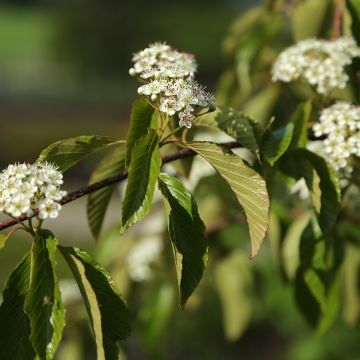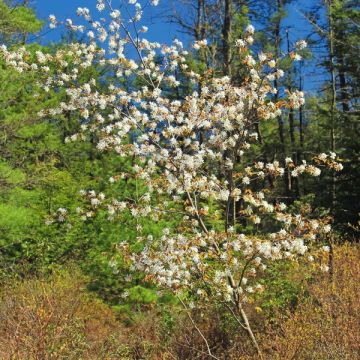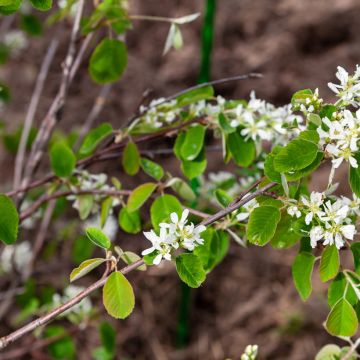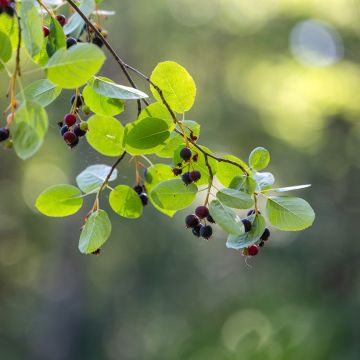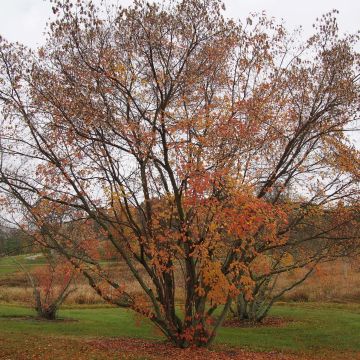

Amelanchier alnifolia GreatBerry Fruity - Saskatoon
Amelanchier alnifolia GreatBerry Fruity - Saskatoon
Amelanchier alnifolia GreatBerry® Fruity 'Kojuaagr'
Saskatoon, Serviceberry, Juneberry
Special offer!
Receive a €20 voucher for any order over €90 (excluding delivery costs, credit notes, and plastic-free options)!
1- Add your favorite plants to your cart.
2- Once you have reached €90, confirm your order (you can even choose the delivery date!).
3- As soon as your order is shipped, you will receive an email containing your voucher code, valid for 3 months (90 days).
Your voucher is unique and can only be used once, for any order with a minimum value of €20, excluding delivery costs.
Can be combined with other current offers, non-divisible and non-refundable.
Home or relay delivery (depending on size and destination)
Schedule delivery date,
and select date in basket
This plant carries a 6 months recovery warranty
More information
We guarantee the quality of our plants for a full growing cycle, and will replace at our expense any plant that fails to recover under normal climatic and planting conditions.
Description
Amelanchier alnifolia GreatBerry Fruity 'Kojuaagr' is a robust variety that forms a small upright tree of 4 m in height with multiple trunks. This fruit tree, native to North America, has long been appreciated for its edible, tasty, and highly nutritious fruits, known as 'saskatoon' by Native Americans. Following its white spring flowering, clusters of dark and sweet fruits appear, with a flavour reminiscent of blueberries, apples, almonds, and hazelnuts. They are harvested in July and August in this non-early variety and can be consumed fresh, dried, in jelly, jam, or in desserts and pastries. Amelanchiers are easy-to-grow and highly rewarding shrubs or small trees. They make excellent bushes for informal hedges, hedgerows, or rural settings.
Originating from North America, from Alaska to Maine, the Amelanchier alnifolia is a sturdy shrub from the large Rosaceae family, largely spared from parasites and resistant to extreme cold. In nature, it is found along watercourses as well as in much less favourable environments, such as rocky slopes exposed to the wind. It thrives in rather acidic and cool soil, proving adaptable and capable of adjusting to relatively dry and hot summers once established. To achieve a good harvest, it is advisable to provide it with fairly fertile soil and water inputs if necessary.
Its habit is bushy and branched, taller than wide. With a rather slow growth rate, the shrub will reach about 4 m in height with a spread of 2.5 to 3.5 m at maturity. Its bark is grey to brown, sometimes tinged with red. Smooth when young, it becomes rougher with age. The abundant flowering occurs in April-May, at the end of bare young branches or already adorned with very young leaves, depending on the climate. Flowering and fruiting are rapid in this amelanchier, around the age of 3-4 years. The white flowers with 5 petals and yellow stamens, 2 cm in diameter, are clustered along the branches. They are followed by round, edible fruits resembling blueberries, called pomes. They turn almost black when ripe, in June. Their pleasantly sweet and aromatic flavour and juicy pulp make them suitable for consumption fresh or cooked, in jam or jelly. Recent analyses confirm their high content of antioxidant molecules, vitamins, and minerals. Saskatoons have a limited shelf life. They can be eaten fresh, frozen, dried, or preserved for later use. A single plant is sufficient to obtain a harvest ranging from 3 kg up to 7-8 kg of fruits depending on soil richness, but it is often recommended to plant two plants to optimise fruit formation.
The young spring leaves are fuzzy, becoming tougher over time. They display a lovely bluish-green hue, turning yellow in autumn before falling. Measuring up to 5 cm in length, they are entire, ovate, serrated at the edges and arranged alternately on the branches.
Amelanchier GreatBerry Fruity is a sturdy, undemanding fruiting shrub as charming as it is deserving of a place in a rural, informal, or fruit hedge. It can also be used in the background of perennial or lower shrub borders. It pairs beautifully with ornamental apple and cherry trees, deciduous euonymus, Japanese quince, spring spireas, hawthorns, loquat trees, prunus, and many more. Create a fruit hedge by combining it, for example, with mayberry (Lonicera kamtschatica Sweet Myberry), garden blackberries, redcurrants, blackcurrants, cranberries (Vaccinium macrocarpon), blueberry bushes, raspberry bushes, Aronia, Japanese silverberry...
The name 'Saskatoon', an anglicisation of a word from the Cree people's language, can be translated as "the fruit of the tree with many branches". This fruit gave its name to the Canadian city of Saskatoon.
Plant habit
Fruit
Flowering
Foliage
Botanical data
Amelanchier
alnifolia
GreatBerry® Fruity 'Kojuaagr'
Rosaceae
Saskatoon, Serviceberry, Juneberry
Cultivar or hybrid
Other Saskatoon - Juneberry
View all →Planting and care
Amelanchier GreatBerry Fruity should be planted in spring or autumn in any good, well-drained garden soil, preferably moist or slightly damp, deep, in a sunny or semi-shaded position. It prefers slightly acidic to neutral soils but can tolerate some limestone. This bush, which doesn't like too arid conditions, can, however, withstand moderate summer drought once well established. Water regularly to help it settle in, especially during the first two dry summers. Mulch the soil to maintain some moisture, always after watering your Amelanchier abundantly so that its roots do not develop only at the surface of the soil, making it more sensitive to water shortage.
Each spring, apply well-decomposed compost at the base of your bush to support fruit production.
You can prune the bush from the first year to encourage branching. Watch out for powdery mildew! As a preventive measure, spray a sulphur-based fungicide if spring is mild and very humid. Like all bushes in the Rosaceae family, Amelanchier can be susceptible to bacterial fire.
Planting period
Intended location
Care
Planting & care advice
This item has not been reviewed yet - be the first to leave a review about it.
Similar products
Haven't found what you were looking for?
Hardiness is the lowest winter temperature a plant can endure without suffering serious damage or even dying. However, hardiness is affected by location (a sheltered area, such as a patio), protection (winter cover) and soil type (hardiness is improved by well-drained soil).

Photo Sharing Terms & Conditions
In order to encourage gardeners to interact and share their experiences, Promesse de fleurs offers various media enabling content to be uploaded onto its Site - in particular via the ‘Photo sharing’ module.
The User agrees to refrain from:
- Posting any content that is illegal, prejudicial, insulting, racist, inciteful to hatred, revisionist, contrary to public decency, that infringes on privacy or on the privacy rights of third parties, in particular the publicity rights of persons and goods, intellectual property rights, or the right to privacy.
- Submitting content on behalf of a third party;
- Impersonate the identity of a third party and/or publish any personal information about a third party;
In general, the User undertakes to refrain from any unethical behaviour.
All Content (in particular text, comments, files, images, photos, videos, creative works, etc.), which may be subject to property or intellectual property rights, image or other private rights, shall remain the property of the User, subject to the limited rights granted by the terms of the licence granted by Promesse de fleurs as stated below. Users are at liberty to publish or not to publish such Content on the Site, notably via the ‘Photo Sharing’ facility, and accept that this Content shall be made public and freely accessible, notably on the Internet.
Users further acknowledge, undertake to have ,and guarantee that they hold all necessary rights and permissions to publish such material on the Site, in particular with regard to the legislation in force pertaining to any privacy, property, intellectual property, image, or contractual rights, or rights of any other nature. By publishing such Content on the Site, Users acknowledge accepting full liability as publishers of the Content within the meaning of the law, and grant Promesse de fleurs, free of charge, an inclusive, worldwide licence for the said Content for the entire duration of its publication, including all reproduction, representation, up/downloading, displaying, performing, transmission, and storage rights.
Users also grant permission for their name to be linked to the Content and accept that this link may not always be made available.
By engaging in posting material, Users consent to their Content becoming automatically accessible on the Internet, in particular on other sites and/or blogs and/or web pages of the Promesse de fleurs site, including in particular social pages and the Promesse de fleurs catalogue.
Users may secure the removal of entrusted content free of charge by issuing a simple request via our contact form.
The flowering period indicated on our website applies to countries and regions located in USDA zone 8 (France, the United Kingdom, Ireland, the Netherlands, etc.)
It will vary according to where you live:
- In zones 9 to 10 (Italy, Spain, Greece, etc.), flowering will occur about 2 to 4 weeks earlier.
- In zones 6 to 7 (Germany, Poland, Slovenia, and lower mountainous regions), flowering will be delayed by 2 to 3 weeks.
- In zone 5 (Central Europe, Scandinavia), blooming will be delayed by 3 to 5 weeks.
In temperate climates, pruning of spring-flowering shrubs (forsythia, spireas, etc.) should be done just after flowering.
Pruning of summer-flowering shrubs (Indian Lilac, Perovskia, etc.) can be done in winter or spring.
In cold regions as well as with frost-sensitive plants, avoid pruning too early when severe frosts may still occur.
The planting period indicated on our website applies to countries and regions located in USDA zone 8 (France, United Kingdom, Ireland, Netherlands).
It will vary according to where you live:
- In Mediterranean zones (Marseille, Madrid, Milan, etc.), autumn and winter are the best planting periods.
- In continental zones (Strasbourg, Munich, Vienna, etc.), delay planting by 2 to 3 weeks in spring and bring it forward by 2 to 4 weeks in autumn.
- In mountainous regions (the Alps, Pyrenees, Carpathians, etc.), it is best to plant in late spring (May-June) or late summer (August-September).
The harvesting period indicated on our website applies to countries and regions in USDA zone 8 (France, England, Ireland, the Netherlands).
In colder areas (Scandinavia, Poland, Austria...) fruit and vegetable harvests are likely to be delayed by 3-4 weeks.
In warmer areas (Italy, Spain, Greece, etc.), harvesting will probably take place earlier, depending on weather conditions.
The sowing periods indicated on our website apply to countries and regions within USDA Zone 8 (France, UK, Ireland, Netherlands).
In colder areas (Scandinavia, Poland, Austria...), delay any outdoor sowing by 3-4 weeks, or sow under glass.
In warmer climes (Italy, Spain, Greece, etc.), bring outdoor sowing forward by a few weeks.



































